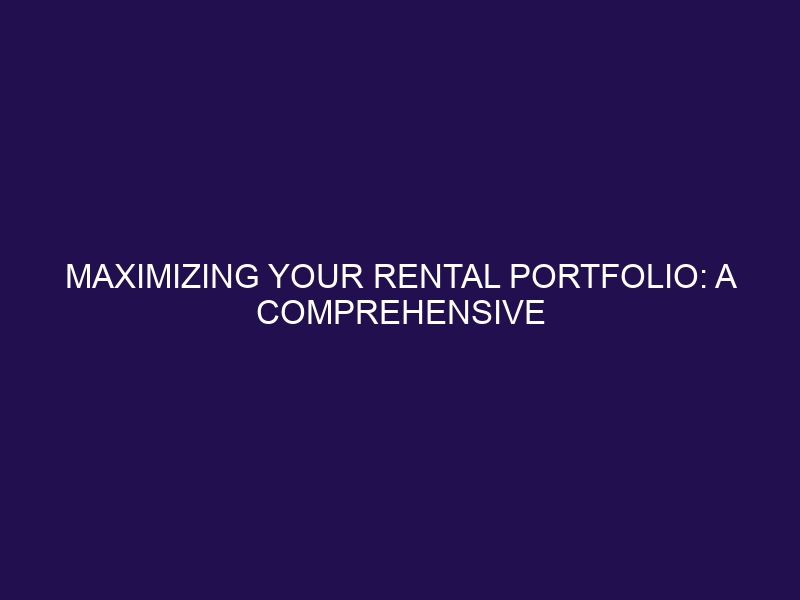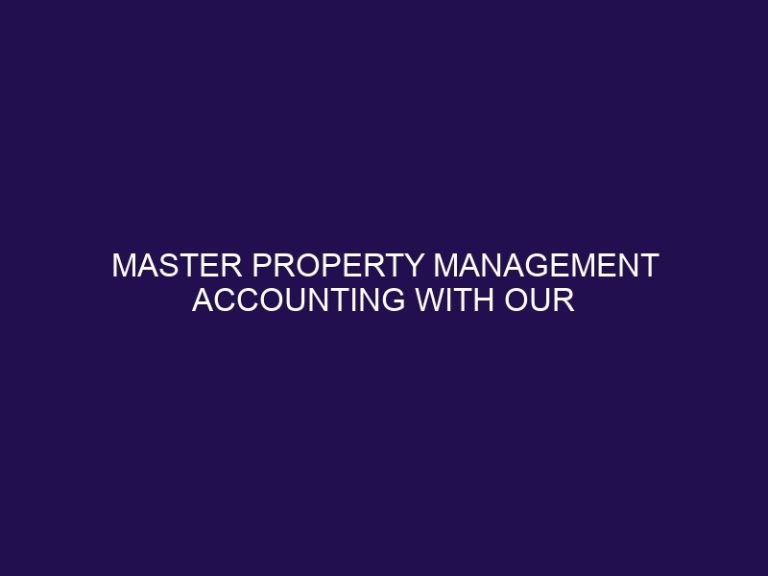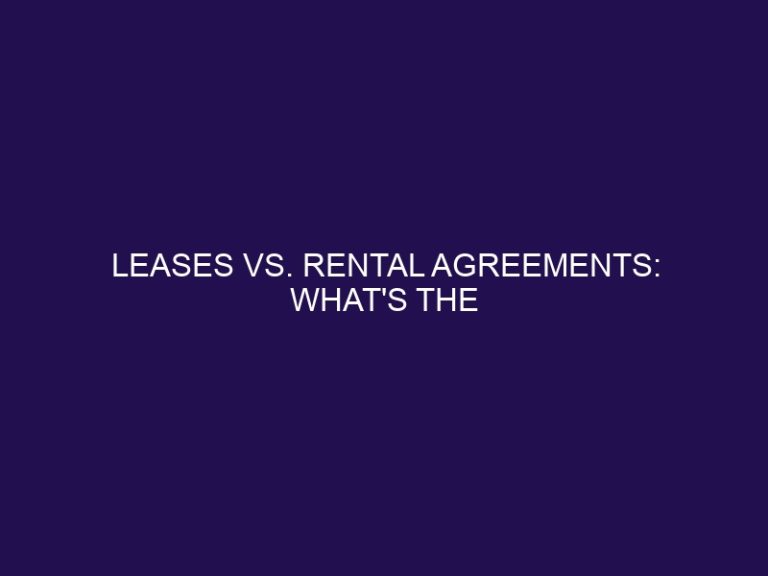Maximizing Your Rental Portfolio: A Comprehensive Guide
Are you looking to expand your real estate investment portfolio and maximize your returns? Whether you’re a seasoned investor or just starting out, understanding the process of growing your rental portfolio is crucial for long-term success.
In this comprehensive guide, we’ll walk you through the step-by-step process of building and managing a successful rental property business. From creating a solid real estate investment plan to researching the market and making strategic property selections, we’ll cover it all. We’ll address common questions about profit expectations, creating a portfolio from scratch, and the importance of rental property insurances.
So, if you’re ready to take your real estate investment journey to the next level, keep reading for valuable insights and actionable tips.
Key Takeaways:
Step-by-Step Guide: Growing Your Rental Portfolio
Growing your rental portfolio requires a strategic approach and a thorough understanding of real estate investment. It involves acquiring and managing multiple rental properties to generate rental income and build a solid real estate investment portfolio.
In terms of the significant role of rental income in achieving financial goals, it’s essential to comprehend that a well-managed rental portfolio growth can provide a steady stream of passive income and potentially long-term wealth accumulation. Diversifying the rental portfolio across different types of properties and locations can also help mitigate risks and maximize overall returns.
Successful property management practices, such as maintaining high occupancy rates, conducting regular property maintenance, and staying updated with local rental market dynamics, are critical for sustaining rental income and ensuring the continued growth of the rental portfolio.
Understanding Real Estate Investment
Real estate investment involves the acquisition, ownership, and management of various property types, such as single-family homes, multifamily properties, and commercial properties, with the primary goal of generating rental income and building a profitable rental portfolio.
What Is a Rental Property Business?
A rental property business involves the ownership and management of residential or commercial properties that are leased to tenants in exchange for rental income. It requires effective property management, understanding of the rental market, and strategic planning to attract and retain quality tenants.
Tenant management is a crucial aspect of running a successful rental property business. This involves screening prospective tenants, handling lease agreements, addressing maintenance requests, and ensuring tenant satisfaction. Moreover, property marketing plays a vital role in maximizing occupancy rates. Utilizing various marketing channels, such as online listings, social media, and signage, helps in reaching potential renters.
Additionally, business planning encompasses financial forecasting, budgeting, and setting objectives for growth and profitability, ensuring the long-term sustainability of the rental property venture.
Importance of Growing Your Real Estate Portfolio
Growing your real estate portfolio is essential for expanding your rental business, diversifying your investment holdings, and maximizing rental income to achieve long-term financial goals. It also strengthens your position in the rental market and enhances the overall stability of your rental business.
Expanding your real estate portfolio offers numerous benefits. Diversification across different properties can help mitigate risks associated with vacancies or market fluctuations, thereby providing a more stable income stream. It allows for increased scalability, enabling you to reach a wider audience of potential tenants and cater to diverse rental needs.
As your portfolio grows, you can tap into the potential for higher returns on investment through strategic property acquisitions and rental property appreciation. This, in turn, contributes to the overall financial strength of your rental business, paving the way for potential expansion and diversification into new real estate markets.
Planning Your Rental Portfolio Growth
Planning the growth of your rental portfolio involves developing a comprehensive real estate investment plan, setting SMART (Specific, Measurable, Achievable, Relevant, Time-bound) goals, choosing an investment strategy aligned with your risk tolerance and market conditions, and exploring various acquiring and financing options to support your portfolio expansion.
Create Your Real Estate Investment Plan
Creating a comprehensive real estate investment plan involves conducting in-depth market research, identifying suitable investment properties, and outlining clear financial goals to guide your rental portfolio expansion strategy.
Market analysis is fundamental in understanding the dynamics of supply and demand, local economic indicators, and demographic trends that can impact property values and rental potential. Property selection criteria should include factors such as location, property condition, rental demand, potential for appreciation, and cash flow.
Financial goal-setting is crucial for determining the desired return on investment, establishing a budget for property acquisition and renovations, and devising strategies for portfolio diversification.
Set SMART Goals
Setting SMART goals for your rental portfolio growth involves defining specific objectives, establishing measurable performance indicators, ensuring goal achievability, aligning with the relevance of your real estate investment, and setting a time-bound framework to track progress and success in property management and rental income generation.
Specificity in your goals means identifying clear and precise targets, such as increasing the number of rental properties or achieving a certain level of monthly rental income. Measurability involves quantifying your objectives, like setting a goal to reach a specific net operating income or occupancy rate.
Achievability requires assessing the resources and capabilities needed to accomplish these goals within your financial and operational constraints. Relevance is critical in the context of your real estate investment strategy, ensuring that the goals align with your long-term plans, whether it’s diversifying your portfolio or focusing on a particular market segment. Incorporating a time-bound aspect establishes deadlines and milestones, allowing you to monitor progress and make adjustments if needed.
Choose Your Investment Strategy
Choosing the right investment strategy for your rental portfolio involves evaluating the rental market, understanding investor preferences, and determining the most suitable property types and market conditions to optimize your investment returns and achieve sustainable growth in your rental business.
When evaluating the rental market, it’s essential to consider factors such as population growth, employment opportunities, and rental demand. Understanding investor preferences involves researching the target tenant demographic and their housing needs, as well as analyzing the affordability and desirability of certain neighborhoods.
Determining the most suitable property types requires a thorough understanding of the various options such as single-family homes, multi-family units, or commercial properties, considering their potential rental income, maintenance costs, and appreciation potential.
Assessing market conditions involves monitoring key indicators such as interest rates, housing inventory levels, and local economic trends to make informed decisions that can impact the performance of your rental investments.
Assess Your Risk Tolerance
Assessing your risk tolerance in property investments is crucial for making informed decisions on financing options, property types, and market conditions that align with your investment goals and the growth trajectory of your rental business.
Understanding your risk tolerance involves evaluating your willingness and ability to withstand potential losses or fluctuations in property values. This assessment directly impacts your financing decisions, as a higher risk tolerance may lead to leveraging with loans or taking on more aggressive financial strategies to maximize returns. On the contrary, a low-risk tolerance may steer you towards conservative financing options, such as self-funding or low leverage to ensure capital preservation.
Your risk tolerance influences property selection. For instance, high-risk tolerance investors may be inclined towards properties with higher potential returns but also higher volatility, while low-risk tolerance investors may prefer stable, less volatile properties that offer steady, predictable income streams.
Market dynamics are also intrinsically linked to risk tolerance. Investors with high risk tolerance might be more willing to enter volatile markets with anticipated high growth, while those with lower risk tolerance may opt for stable, established markets with lower growth potential but with reduced risk exposure.
Researching the Real Estate Market
Researching the real estate market involves analyzing rental rates, evaluating vacancy rates, and understanding the dynamics of the local rental market to identify opportunities for property acquisition, assess tenant demand, and maximize rental income potential for your growing rental portfolio.
Analyze Rental Rates
Analyzing rental rates is essential for understanding the prevailing market conditions, assessing the income potential of rental properties, and identifying opportunities to maximize rental income by catering to the needs and preferences of potential tenants in the target market.
By conducting a comprehensive analysis of rental rates, property owners and managers can gain valuable insights into the competitive landscape. Understanding the current market conditions allows them to strategically position their properties to attract tenants.
Moreover, rental rates directly impact the income potential of investment properties. Setting the right rental price is crucial for establishing a steady and lucrative stream of rental income.
Aligning rental rates with the demands of potential tenants is imperative for ensuring high occupancy rates and tenant retention. By offering competitive rates that reflect the value and amenities of the property, landlords can effectively meet tenants’ expectations and enhance their overall renting experience.
Evaluate Vacancy Rates
Evaluating vacancy rates in the rental market provides crucial insights into the demand-supply dynamics, tenant turnover, and the competitive landscape in the local market, helping you make informed decisions to minimize vacancies and sustain the growth of your rental business.
Understanding the vacancy rates is vital as it directly impacts the rental market’s equilibrium. High vacancy rates can signify a market with excess supply, leading to decreased rental prices and increased competition among property owners. On the other hand, low vacancy rates indicate a high demand for rental properties, potentially allowing landlords to adjust rental rates favorably.
Moreover, vacancy rates influence tenant retention. By identifying and addressing the reasons for high turnover, landlords can improve their property management practices, enhance tenant satisfaction, and ultimately reduce vacancies. This, in turn, fosters a stable and sustainable rental business.
Building and Managing Your Rental Portfolio
Building and managing your rental portfolio involves the strategic principles of diversification, meticulous property selection, and the effective utilization of technology and property management resources to optimize the performance of diverse property types, including single-family homes, multifamily properties, and commercial properties, while ensuring timely maintenance and upkeep.
Diversification and Scaling
Diversification and scaling your rental portfolio involve expanding your property holdings across different property types and locations, aligning with your risk tolerance and the prevailing market conditions to achieve sustainable growth and mitigate investment risks in your real estate portfolio.
Diversification is crucial to minimize the impact of market fluctuations on your real estate holdings. By holding diverse property types, such as residential, commercial, and mixed-use properties, you can spread your risk and optimize your returns. Scaling your portfolio involves gradually acquiring additional properties, carefully considering the financial feasibility and potential returns of each acquisition. This strategic approach can help you build a robust and resilient real estate portfolio that is resistant to localized market downturns.
In terms of property type considerations, it’s essential to analyze the unique characteristics and demand dynamics of each segment. Residential properties, for example, cater to a broad tenant base, while commercial properties offer potential for long-term leases with established businesses. Mixed-use properties provide a blend of residential and commercial components, offering diversified income streams. Understanding these nuances can guide your decisions in diversifying your portfolio.
To mitigate risks, it’s advisable to conduct thorough due diligence on each property acquisition, considering factors such as location stability, rental demand, and potential capital appreciation. Implementing leverage conservatively and maintaining sufficient liquidity can cushion against unforeseen market downturns, serving as effective risk mitigation strategies.
The impact of market dynamics on your rental portfolio cannot be understated. Economic shifts, demographic changes, and regulatory developments can significantly influence property values and rental demand. By staying attuned to market trends and adapting your investment strategy accordingly, you can capitalize on growth opportunities and shield your portfolio from adverse conditions.
Tips for Property Selection
Effective property selection involves conducting thorough market analysis, evaluating property management resources, understanding the dynamics of the local market, and aligning property features with the needs and preferences of potential tenants to make informed decisions that enhance the performance of your rental portfolio.
Market analysis plays a crucial role in determining the demand and supply dynamics, rental value projections, and potential growth opportunities in a given location. It helps in identifying the most favorable areas for investment, taking into account factors such as employment opportunities, infrastructure development, and demographic trends.
- Effective property management is essential for ensuring the well-maintained and attractive appearance of the property, thereby enhancing its appeal to potential tenants and ensuring long-term value appreciation.
- Considering tenant preferences and their lifestyle requirements, such as proximity to amenities, transportation, and educational institutions, is vital to attract and retain desirable long-term tenants, thereby reducing vacancies and turnover costs.
- Understanding local regulations and market trends is crucial to aligning property features with compliance standards and optimizing the property’s potential for attracting quality tenants and maximizing rental income.
Utilizing Technology in Portfolio Management
Utilizing technology in portfolio management involves leveraging advanced property management tools, software solutions, and digital platforms to streamline rental operations, maintenance workflows, and financial tracking, thereby enhancing the efficiency and profitability of your rental business and maximizing rental income potential.
By integrating technology into the management of rental properties, property managers can benefit from enhanced visibility and control over their assets. The use of specialized tools and software solutions allows for seamless monitoring of tenant payments, maintenance requests, and property performance metrics.
This level of automation facilitates expedited responses to maintenance issues, reducing downtime while improving tenant satisfaction. Advanced reporting and analytics provided by these technologies enable property owners to make well-informed decisions, optimize rental pricing strategies, and identify areas for cost savings.
In addition, the adoption of digital platforms for marketing, tenant communication, and leasing processes can lead to increased visibility in the market and accelerated tenant acquisition. By leveraging these technological advancements, property managers can effectively enhance their overall operational efficiency, mitigate potential risks, and unlock new revenue streams within their rental portfolio.
Frequently Asked Questions
Addressing frequently asked questions about rental portfolio growth involves clarifying profit expectations, explaining the concept of passive income, discussing real estate portfolio management, and highlighting the role of rental property insurances in safeguarding your real estate investments and rental business.
Profit Expectations and Passive Income
Understanding profit expectations and passive income in rental portfolio growth involves setting realistic financial goals, optimizing rental income streams, and creating a sustainable passive income source through effective real estate investment and property management strategies.
When setting financial goals for rental portfolio growth, it’s crucial to consider factors such as property appreciation, rental demand, and market trends. By identifying clear objectives, investors can gauge profit expectations and work towards achieving them.
Optimizing rental income streams involves pricing properties competitively, maintaining high occupancy rates, and minimizing vacancies through effective marketing and tenant retention strategies. Diversifying the portfolio with different types of properties can also spread out risk and enhance passive income potential.
Creating a sustainable passive income source in real estate can be achieved by investing in income-producing properties, implementing efficient property management practices, and leveraging technology to streamline operations and maximize returns.
Creating a Real Estate Portfolio from Scratch
Building a real estate portfolio from scratch requires meticulous property investing, thorough understanding of the local market, strategic selection of property types, and clear alignment with your financial goals to establish a robust and profitable rental portfolio.
First and foremost, start by researching the local real estate market to gain insights into property trends, rental demands, and potential growth areas. This information will form the foundation for your investment strategy. With your financial goals in mind, consider the property types that best fit your investment objectives. Whether residential properties, commercial spaces, or mixed-use developments, each type offers distinct advantages and considerations.
When choosing properties, factor in essential criteria such as location, condition, rental yield, and long-term appreciation potential. Diversifying your portfolio across different property types can help mitigate risk while maximizing returns. Leverage financing options and tax incentives to optimize your investment returns.
Utilizing Rental Property Insurances
Utilizing rental property insurances is essential for effective risk management in property investments, safeguarding your real estate portfolio, and ensuring comprehensive coverage for property maintenance, liabilities, and unforeseen events that may impact the performance of your rental properties.
Property insurances play a crucial role in protecting your investment from potential risks and financial losses. By having the right insurance coverage, property owners can mitigate the impact of various unforeseen events, such as natural disasters, fire outbreaks, vandalism, or property damages caused by tenants.
Rental property insurances provide financial protection against potential legal liabilities, including tenant injuries or property-related lawsuits. By obtaining liability coverage, landlords can shield themselves from potential costly legal proceedings.
Insurances are vital for property maintenance, as they can cover the costs of repairing damages, which can be particularly beneficial in case of significant and unforeseen damages that may interrupt the rental income flow.
Frequently Asked Questions
What is a rental portfolio?
A rental portfolio is a collection of properties that a landlord owns and manages for the purpose of generating rental income.
Why is it important to grow your rental portfolio?
Growing your rental portfolio allows you to increase your rental income and build long-term wealth through property ownership. It also provides diversification in your investment portfolio.
How do I start growing my rental portfolio?
The first step is to set clear goals and create a plan. This includes determining your budget, identifying potential properties, and establishing criteria for selecting tenants.
What are some strategies for growing a rental portfolio?
Some strategies include purchasing undervalued properties, implementing renovations or upgrades, and investing in high-demand rental markets. Networking with other investors and utilizing financing options can also help in growing your portfolio.
How can I manage and maintain my rental portfolio effectively?
It is important to stay organized and keep track of maintenance and repairs. Hire reliable contractors and establish good communication with tenants. Regularly review your rental rates and make necessary adjustments to stay competitive in the market.
Are there any risks associated with growing a rental portfolio?
As with any investment, there are risks involved in growing a rental portfolio. These can include unexpected expenses, vacancy periods, and potential legal issues with tenants. It is important to conduct thorough research and have a solid financial plan in place to mitigate these risks.







